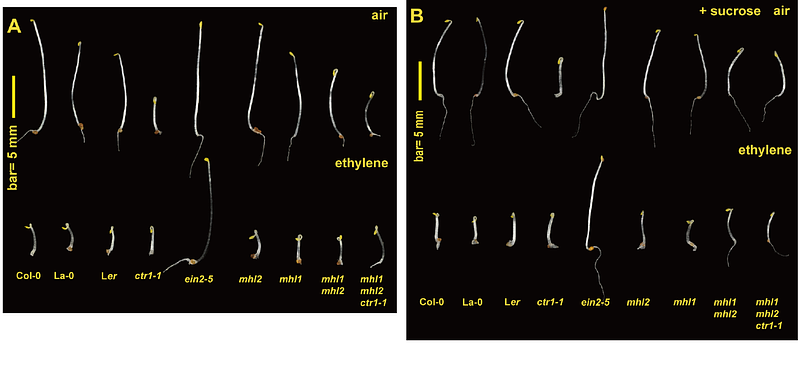Embracing Uncertainty Reshapes the ETHYLENE INSENSITIVE2-Activated Ethylene Signaling Framework

Embracing Uncertainty Reshapes the ETHYLENE INSENSITIVE2-Activated Ethylene Signaling Framework
Zhao, H.; Zhang, Y.; Chen, Y.; Wang, C.; Liu, Q.; Zhang, J.; Wen, C.-K.
AbstractSignal transduction of the gaseous plant hormone ethylene by ETHYLENE INSENSITIVE2 (EIN2) is proposed to be regulated at multiple levels. EIN2 is phosphorylated by CONSTITUTIVE TRIPLE-RESPONSE1 (CTR1), subject to the F-Box proteins [EIN2-TARGETING PROTEIN1 (ETP1) and ETP2]-mediated degradation, and cannot activate ethylene signaling. Ethylene prevents EIN2 phosphorylation and degradation, and EIN2 accumulates and activates the signaling. MAOHUZI3 LIKE1 (MHL1) and MHL2 stabilize EIN2, and the mhl1 mhl2 double mutation confers ethylene insensitivity. Here, we reported that the regulation of EIN2-activated ethylene signaling can be independent of CTR1-mediated phosphorylation, ETP1/ETP2-directed degradation, and MHL1/MHL2-dependent stabilization. Both the etp1 etp2 double mutant and wild type showed identical ethylene dose-response curves, and the nontreated mhl1 mhl2 double mutant displayed substantial growth inhibition. The reported ethylene-insensitive root phenotype of mhl1 mhl2 seedlings requires sucrose and is associated with unknown loci. The ethylene receptor ETHYLENE RESPONSE1 (ETR1) and EIN2 interact in the rough endoplasmic reticulum. We propose that the docking of CTR1 to ETR1 promotes receptor signaling, which inhibits EIN2-activated ethylene signaling. The discrepancy between our findings and the current model is discussed. Our findings may disrupt the knowledge boundary of the present molecular model, developing a niche for findings outside the framework to advance our understanding of ethylene signaling.